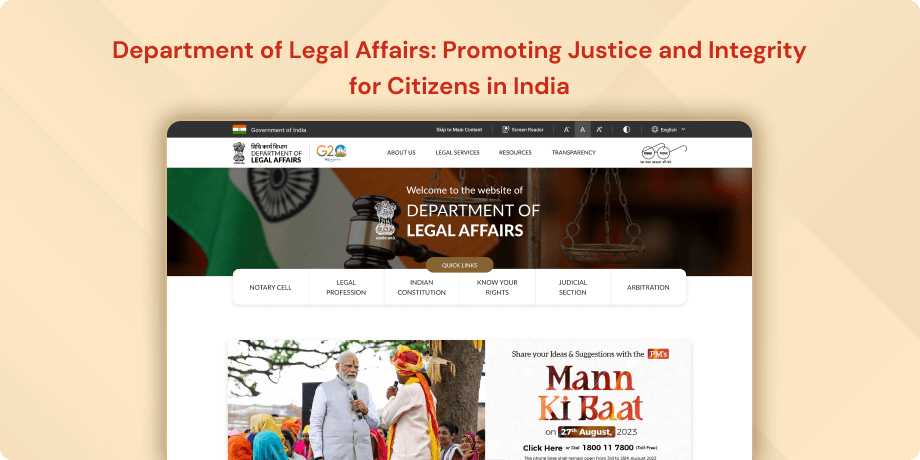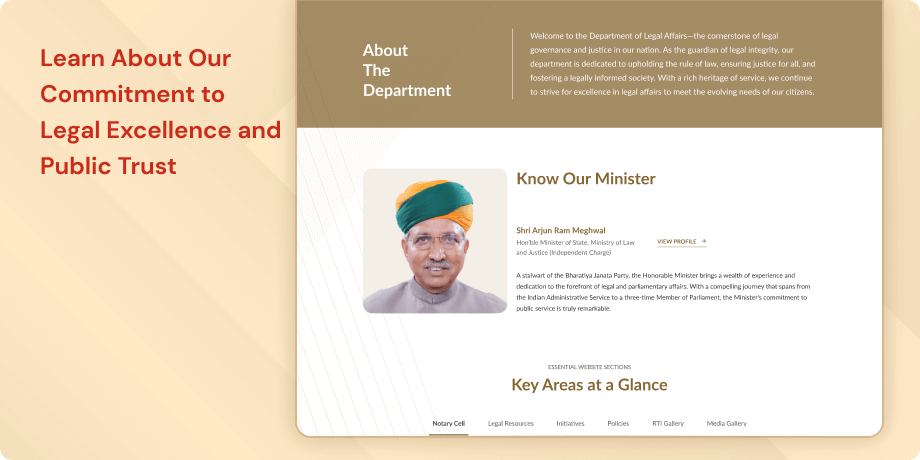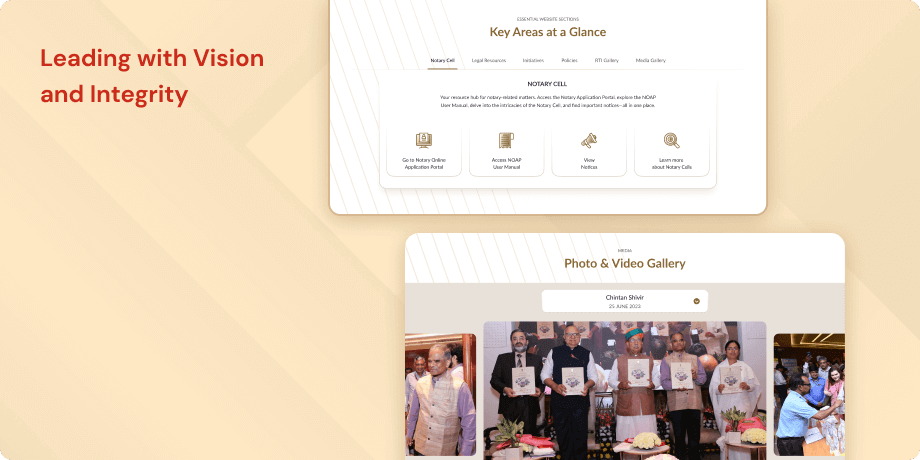introduction
The Legal affairs serves as the official website of the Department of Legal Affairs, operating under the Ministry of Law and Justice in India. Its purpose is to furnish comprehensive information on the department's functions, services, organizational structure, budget, publications, and contact details. The website also facilitates various online services, including e-filing of cases, e-payment of court fees, e-stamping, e-notary, and access to e-seva kendra. Designed as a unified platform, the website aims to cater to the diverse legal needs of the government of India and its citizens. The intended users encompass a wide spectrum, ranging from lawyers, judges, and government officials to litigants, researchers, students, and the public.
Objective
- Legal Information and Resources- The primary goal of legalaffairs.gov.in is to function as a comprehensive platform, offering legal information, resources, and pertinent documents relevant to the Department of Legal Affairs in India. The website aims to be a trustworthy source of legal content for the public, legal professionals, and stakeholders.
- Transparency and Public Engagement- The website strives to enhance transparency and engage the public by granting access to government policies, laws, regulations, and initiatives related to legal affairs. Its objective is to foster an informed citizenry by making legal information easily accessible and understandable.
- Government Services and Online Facilities- legalaffairs.gov.in aims to provide various online facilities and government services related to legal matters. This includes features such as online filing of legal documents, tracking case status, and offering e-services for legal professionals.
- Ministerial and Departmental Updates- The website intends to keep the public updated on the latest news, events, and developments within the Ministry of Legal Affairs. This encompasses updates related to the Minister of Law and Justice and other key officials.
- Education and Awareness- Another objective is to educate and create awareness among the public about their legal rights, responsibilities, and legal procedures. The website may offer educational resources, FAQs, and legal guides to enhance legal literacy.
Target Audience
The targeted users of the legal affairs website encompass a diverse audience with various interests and needs. The following groups are likely to benefit from the website-
- General Public- Individuals seeking legal information, resources, and documents relevant to legal affairs in India. This includes those interested in understanding their legal rights and responsibilities.
- Legal Professionals- Lawyers, judges, and legal practitioners who may utilize the website for accessing legal content, government policies, laws, and regulations. The online facilities, such as e-filing of legal documents, can be particularly useful for legal professionals.
- Stakeholders- Individuals or entities with a vested interest in legal affairs, such as businesses, organizations, or advocacy groups, seeking information on legal developments and policies. .
- Government Officials- Those within the government involved in legal matters, policy implementation, and updates related to the Ministry of Legal Affairs.
- Students- Students pursuing legal studies can use the website for educational resources, legal guides, and FAQs to enhance their legal literacy.
- Citizens Seeking Government Services- Individuals interested in utilizing online facilities and government services related to legal matters, such as filing legal documents or tracking case status.
- Individuals Interested in Ministerial and Departmental Updates- Those wanting to stay informed about the latest news, events, and developments within the Ministry of Legal Affairs, including updates related to key officials.
The website aims to be a comprehensive platform catering to the diverse needs of these user groups, promoting transparency, accessibility and engagement across various stakeholders.
The Challenge
Enhancing the user experience on the website involves tackling several challenges that users may face. These challenges encompass streamlining the search process, improving search flexibility, providing sufficient feedback and information, ensuring data accuracy and consistency, optimizing mobile responsiveness, prioritizing accessibility, and refining the user interface to make it more intuitive. By addressing these key areas, the goal is to create a more user-friendly and efficient platform for individuals navigating the website.
Usability Study Findings
This usability study analyzes the user behavior, preferences and pain points. The focus is on addressing issues related to content accuracy, trustworthiness, and identifying outdated information on the website. User feedback is being actively sought to pinpoint navigation challenges and prioritize improvements according to user preferences. This holistic approach ensures that the website is refined in alignment with user needs, fostering a more seamless and trustworthy online experience.
Homepage- Carousel Navigation Enhancement- Add directional arrows and reposition pagination indicators for clearer navigation.
- Optimizing Visual Hierarchy- Rearrange homepage sections for a clearer visual hierarchy to enhance user experience.
- Refinement of "Quick Actions" Section-Review and optimize the "Quick Actions" section for relevancy and efficiency.
- Incorporating Essential Entry Points-Include prominent entry points for reporting crimes, filing complaints, and justice topics on the homepage.
- Streamlining Quick/Useful Links Sections- Organize and differentiate between internal actions and external links in the Quick/Useful Links sections.
- Implementing a Comprehensive Footer- Introduce a well-organized footer with essential links for consistency and usability.
- Limited Content on the Webpage- Enhance content on the "Judicial Section" page to provide comprehensive information about its functions and role.
- User Expectations Unmet-Provide detailed information on the page itself to meet user expectations without relying on external document downloads.
- Inconvenient PDF Access- Ensure essential information is accessible directly on the webpage, avoiding the need for users to download PDFs.
- Document Content Ambiguity and Absence of Categorization-Clearly categorize and organize documents on the "Notary Section" page for better user understanding.
- Inadequate Placement of Functions Information- Display functions information within the webpage body instead of behind a button and avoid redirecting to PDFs.
- Suboptimal Design and Navigation to Subdomain- Consider integrating the "Notary Section" within the main website for a cohesive user experience.
- Unclear and Untitled Grid Icons Section-Provide a clear title and explanation for the section with grid icons to improve user understanding.
- Insufficient Context for Document Viewer Pages - Add context and explanations on internal pages directing users to document viewers for improved clarity.
- Unclear External Link with Insufficient Context- Provide context for external links to ensure users understand the content they will encounter.
- Addressing Unrelated Links in Icon Section- Clarify the purpose and relevance of the "Online Course" link in relation to other icons.
- Inefficient Content Presentation- Avoid using PDFs for limited information; present details directly on the website for better accessibility.
- Inconsistent and Unnecessary Links-Review and consolidate links within the "About Us" dropdown for improved organization and consistency.
- Presence of Outdated Information-Regularly update content, especially ministerial information, to maintain trust and credibility.
- Lack of a Comprehensive Footer- Introduce a comprehensive footer for better navigation and accessibility.
Implementing these recommendations will likely result in a more user-friendly and efficient website, addressing the identified issues and enhancing the overall user experience. Regular usability testing and feedback collection should be integrated to continually refine and improve the website based on user needs.
Synthesizing Phase
With the insights gathered during the research phase, we have gained valuable understanding of the users' interactions and challenges while using the website of Department of Legal Affairs, a statutory body of the Government of India. Building on this knowledge, we have now entered the Defining phase, where our aim is to deepen our comprehension and transform the research findings into practical design solutions. To maintain a user-centric approach, we have created personas that embody essential user archetypes-
User Personas Persona 1- Legal Professional - SarahIrene, a 40-year-old business owner from the United States, is a seasoned investor with a successful track record in various countries.
Goals-Her primary goals include efficiently finding and accessing specific legal documents for her cases, utilizing online facilities for streamlined e-filing of legal documents, and staying informed about the latest legal developments within the Ministry of Legal Affairs.
Challenges-Sarah faces challenges in the form of a complex search process that hampers her quick location of specific documents. Additionally, limited flexibility in search options, unclear feedback on e-filed document status, and mobile responsiveness issues on her tablet or smartphone contribute to potential delays and inefficiencies in her workflow.
Persona 2- Citizen –RajRaj is an ordinary citizen seeking legal information on legalaffairs.gov.in to better understand his rights and responsibilities. He is not familiar with legal jargon and relies on the website for simplified explanations.
Goals-His goals encompass easily comprehending legal information, utilizing online facilities for government services, and staying updated on the latest legal news and initiatives.
Challenges-Raj faces challenges related to the complex legal terminology used on the website, hindering his understanding of the content. Unfamiliar with legal jargon, he seeks simplified explanations on the website. Navigational difficulties arise due to a less-intuitive user interface, and he has limited awareness of available online facilities and how to use them effectively. Concerns about the website's accessibility on his mobile phone add to Raj's challenges, as he primarily accesses the internet through his smartphone.
Mapping User Journeys and Extracting InsightsWe have selected Sarah, a seasoned lawyer specializing in corporate law, to delve into the intricacies of her needs, pain points, and behaviors when navigating the legalaffairs.gov.in website. Sarah's wealth of experience sheds light on the motivations and challenges encountered by legal professionals seeking specific and up-to-date information within the realm of corporate law. Our aim is to illuminate Sarah's journey and experiences on the legalaffairs.gov.in platform, offering a detailed exploration of her interactions, emotions, pain points, and overall user experience while sourcing essential resources for her legal work.
Mapping the Journey to a "User Story"Through a meticulous analysis of Sarah's user journey map, we've garnered profound insights into the actions, emotions, and pain points that Sarah faces when engaging with the legalaffairs.gov.in website. This customized journey map caters to Sarah's precise objectives and requirements as a seasoned lawyer, spotlighting critical touchpoints where she encounters challenges and highlighting potential areas for improvement.
User Story for Sarah"As a seasoned lawyer specializing in corporate law, I want a user-friendly and efficient search system on legalaffairs.gov.in, providing clear feedback on e-filed documents and ensuring optimal mobile responsiveness. This will streamline my document retrieval, e-filing process, and enable seamless access to the latest legal developments."
Framing Challenges and Hypothesis for Sarah Problem StatementSarah, a seasoned lawyer, faces challenges with the complex search process, unclear e-filing feedback, and mobile responsiveness issues on legalaffairs.gov.in. These obstacles hinder her efficiency in accessing vital legal documents, e-filing, and staying updated on legal developments.
Hypothesis StatementIf we implement an intuitive search system, enhance e-filing feedback mechanisms, and optimize the website for mobile access, Sarah's experience on legalaffairs.gov.in will become more efficient, transparent, and conducive to staying informed about the latest legal developments.
In the upcoming sections, we will dive into design solutions to address Sarah's challenges and enhance her user experience on the legal affairs website.




